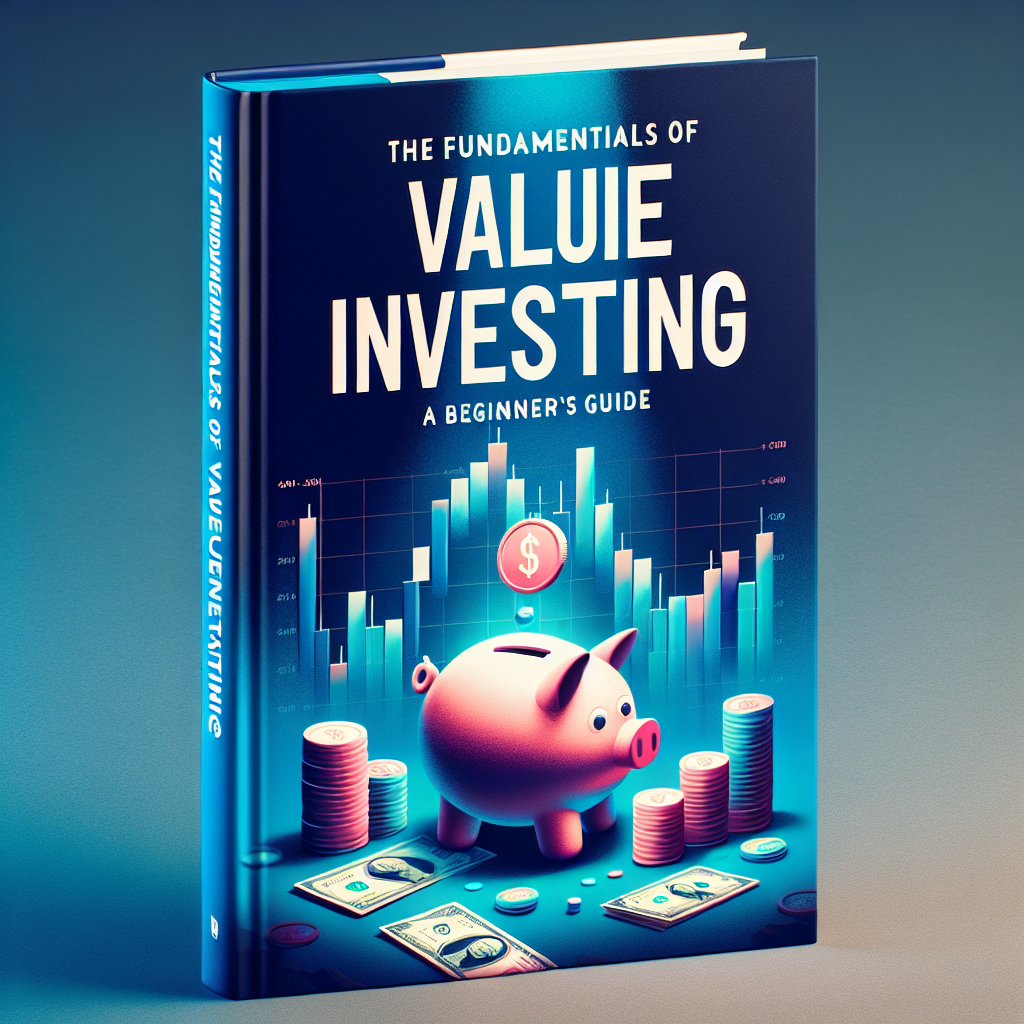
Understanding the Basics of Value Investing: A Comprehensive Guide
Value investing is a popular investment strategy that has been used by successful investors for decades. It involves buying stocks that are undervalued by the market, with the belief that their true value will eventually be recognized and the stock price will rise. This strategy is based on the principle that the market can sometimes misprice stocks, creating opportunities for savvy investors to make a profit.
If you are new to the world of investing, value investing may seem like a daunting concept. However, with a little bit of knowledge and understanding, anyone can learn the fundamentals of value investing and potentially reap the rewards. In this article, we will break down the basics of value investing and provide a comprehensive guide for beginners.
The first step in understanding value investing is to grasp the concept of intrinsic value. Intrinsic value is the true worth of a company, based on its assets, earnings, and potential for growth. It is different from the market value, which is the current price of a stock in the market. Value investors believe that the market can sometimes undervalue a company, and by determining its intrinsic value, they can identify opportunities for investment.
One of the key principles of value investing is the margin of safety. This refers to the difference between the intrinsic value of a stock and its market value. A value investor looks for stocks with a significant margin of safety, as this provides a cushion against potential losses. By buying a stock at a discount to its intrinsic value, investors can minimize their risk and increase their potential for profit.
Another important aspect of value investing is the focus on long-term investing. Value investors are not concerned with short-term fluctuations in the market. Instead, they look for companies with strong fundamentals and a solid track record of performance. By holding onto these stocks for the long term, investors can benefit from the potential growth of the company and the market eventually recognizing its true value.
When it comes to selecting stocks for value investing, there are a few key metrics that investors should pay attention to. These include the price-to-earnings ratio (P/E), price-to-book ratio (P/B), and dividend yield. The P/E ratio compares a company’s stock price to its earnings per share, while the P/B ratio compares the stock price to its book value. A low P/E or P/B ratio can indicate an undervalued stock. Dividend yield, on the other hand, measures the percentage of a company’s stock price that is paid out in dividends. A high dividend yield can be a sign of a stable and profitable company.
In addition to these metrics, value investors also look at a company’s financial health, management team, and competitive advantage. A company with a strong balance sheet, competent leadership, and a unique product or service can be a promising investment opportunity.
It is important to note that value investing is not a foolproof strategy. Like any investment, there is always a risk involved. However, by following the principles of value investing and conducting thorough research, investors can minimize their risk and increase their chances of success.
In conclusion, value investing is a tried and tested investment strategy that has been used by many successful investors. By understanding the concept of intrinsic value, the margin of safety, and the importance of long-term investing, beginners can start their journey into value investing with confidence. Remember to pay attention to key metrics, such as P/E, P/B, and dividend yield, and to thoroughly research a company before making an investment. With patience and diligence, value investing can be a rewarding and profitable venture.
The Importance of Intrinsic Value in Value Investing
Value investing is a popular investment strategy that has been used by successful investors such as Warren Buffett and Benjamin Graham. It involves buying stocks that are undervalued by the market, with the expectation that their value will eventually increase. While it may seem like a simple concept, value investing requires a deep understanding of a company’s intrinsic value. In this article, we will explore the importance of intrinsic value in value investing and how it can help beginners make informed investment decisions.
Intrinsic value is the true or inherent value of a company, independent of its market price. It is determined by the company’s assets, earnings, and potential for growth. In other words, it is the value that a company holds regardless of its current stock price. This is in contrast to extrinsic value, which is the perceived value of a company based on market trends and investor sentiment.
One of the key principles of value investing is to buy stocks at a price lower than their intrinsic value. This allows investors to have a margin of safety, which is the difference between the market price and the intrinsic value of a stock. This margin of safety provides a cushion against potential losses and increases the chances of making a profit.
So, how does one determine the intrinsic value of a company? There are various methods used by value investors, but the most common one is the discounted cash flow (DCF) analysis. This method involves estimating the future cash flows of a company and discounting them to their present value. The resulting figure is the intrinsic value of the company.
Another important aspect of intrinsic value is its long-term perspective. Value investors focus on the long-term potential of a company rather than short-term market fluctuations. This means that they are not concerned with the daily ups and downs of the stock market, but rather the overall performance of the company over time. This approach requires patience and discipline, as it may take some time for the market to recognize the true value of a company.
Intrinsic value also plays a crucial role in risk management. By investing in undervalued stocks, value investors reduce their risk exposure. This is because even if the market price of a stock decreases, the intrinsic value of the company remains the same. This provides a level of protection against market volatility and decreases the chances of losing money.
Moreover, understanding intrinsic value can help investors avoid the pitfalls of speculation. Speculation involves buying stocks based on market trends and speculation rather than the company’s fundamentals. This can be a risky strategy, as it relies heavily on market sentiment and can lead to significant losses. By focusing on intrinsic value, investors can make more informed and rational investment decisions.
In conclusion, intrinsic value is a fundamental concept in value investing. It is the true value of a company, independent of its market price. By understanding and utilizing intrinsic value, investors can make informed investment decisions, reduce their risk exposure, and avoid the pitfalls of speculation. As a beginner in value investing, it is essential to have a solid understanding of intrinsic value and its importance in the investment process. With patience, discipline, and a long-term perspective, value investing can be a successful strategy for building wealth.
How to Identify Undervalued Stocks: A Step-by-Step Approach
Value investing is a popular investment strategy that has been used by successful investors such as Warren Buffett and Benjamin Graham. It involves identifying undervalued stocks and investing in them for the long term, with the belief that their true value will eventually be recognized by the market. This approach requires patience, discipline, and a thorough understanding of the fundamentals of value investing. In this beginner’s guide, we will walk you through the step-by-step process of identifying undervalued stocks.
Step 1: Understand the Concept of Intrinsic Value
The first step in identifying undervalued stocks is to understand the concept of intrinsic value. Intrinsic value is the true worth of a company, based on its assets, earnings, and potential for growth. It is different from the market value, which is the current price of a stock. The goal of value investing is to find stocks that are trading below their intrinsic value, as these are considered to be undervalued.
Step 2: Conduct Fundamental Analysis
The next step is to conduct fundamental analysis on the company whose stock you are interested in. This involves analyzing the company’s financial statements, such as its balance sheet, income statement, and cash flow statement. Look for companies with strong financials, such as a healthy balance sheet, consistent earnings growth, and positive cash flow. These are signs of a financially stable company with the potential for long-term growth.
Step 3: Look for a Margin of Safety
One of the key principles of value investing is to always have a margin of safety. This means buying a stock at a price that is significantly lower than its intrinsic value. This provides a cushion in case the stock price drops, and also increases the potential for higher returns. A good rule of thumb is to look for stocks that are trading at least 25% below their intrinsic value.
Step 4: Analyze the Company’s Competitive Advantage
Another important factor to consider when identifying undervalued stocks is the company’s competitive advantage. This refers to the unique qualities or strengths that give a company an edge over its competitors. Look for companies with a strong brand, a loyal customer base, or a unique product or service. These factors can help a company maintain its competitive edge and continue to grow in the long run.
Step 5: Consider the Industry and Market Trends
It is also important to consider the industry and market trends when identifying undervalued stocks. Look for companies in industries that are expected to grow in the future, such as technology, healthcare, or renewable energy. Also, pay attention to any market trends that could impact the company’s performance, such as changes in consumer behavior or government regulations.
Step 6: Use Valuation Metrics
Valuation metrics, such as price-to-earnings ratio (P/E), price-to-book ratio (P/B), and price-to-sales ratio (P/S), can also be helpful in identifying undervalued stocks. These metrics compare a company’s stock price to its financial metrics, and can give you an idea of whether a stock is undervalued or overvalued. However, it is important to use these metrics in conjunction with other factors, as they do not tell the whole story.
Step 7: Monitor the Stock’s Performance
Once you have identified an undervalued stock and made the investment, it is important to monitor its performance regularly. Keep an eye on the company’s financials, industry and market trends, and any news or events that could impact the stock price. This will help you make informed decisions about when to buy, hold, or sell the stock.
In conclusion, identifying undervalued stocks is a crucial step in value investing. It requires a thorough understanding of the concept of intrinsic value, as well as conducting fundamental analysis, considering a margin of safety, and analyzing the company’s competitive advantage and industry trends. By following these steps and staying disciplined, you can increase your chances of finding undervalued stocks and achieving long-term investment success.
The Role of Patience and Discipline in Value Investing
Value investing is a popular investment strategy that has been used by successful investors such as Warren Buffett and Benjamin Graham. It involves buying stocks that are undervalued by the market, with the belief that their true value will eventually be recognized and the stock price will rise. While this may sound simple, value investing requires a great deal of patience and discipline. In this article, we will explore the role of these two qualities in value investing and how they can help beginners navigate the world of investing.
Patience is a key component of value investing. It is the ability to wait for the right opportunity to present itself, even if it means missing out on short-term gains. In value investing, the goal is to buy stocks at a discount to their intrinsic value, which may take time to be realized. This requires patience, as the stock price may not immediately reflect the true value of the company. As a beginner, it can be tempting to jump into the market and buy stocks that are currently popular or have a high price, but this goes against the principles of value investing. It is important to remember that patience is a virtue in this strategy, and it will pay off in the long run.
Discipline is another crucial aspect of value investing. It is the ability to stick to a plan and not be swayed by market fluctuations or emotions. In value investing, a disciplined approach means having a set of criteria for selecting stocks and sticking to it. This could include factors such as a low price-to-earnings ratio, a strong balance sheet, and a history of consistent earnings. By following a disciplined approach, investors can avoid making impulsive decisions based on short-term market movements. This is especially important for beginners, as they may be more susceptible to emotional decision-making.
One of the key benefits of patience and discipline in value investing is the ability to take advantage of market inefficiencies. The stock market is not always rational, and there are times when good companies are undervalued due to temporary factors such as market sentiment or economic conditions. By being patient and disciplined, investors can identify these opportunities and take advantage of them. This is where the famous quote by Warren Buffett comes into play, “Be fearful when others are greedy and greedy when others are fearful.” By having the patience to wait for the right opportunity and the discipline to stick to a plan, investors can capitalize on these market inefficiencies and potentially earn higher returns.
Another important aspect of value investing is the focus on the long-term. This ties in with the idea of patience and discipline. Value investors are not concerned with short-term market fluctuations, but rather the long-term potential of a company. This means that they are willing to hold onto a stock for an extended period of time, even if it means enduring short-term losses. By having a long-term perspective, investors can avoid being swayed by short-term market movements and focus on the fundamentals of the company.
In conclusion, patience and discipline are essential qualities for successful value investing. They allow investors to take advantage of market inefficiencies, stick to a plan, and focus on the long-term potential of a company. As a beginner, it is important to remember that value investing is a long-term strategy and requires patience and discipline to be successful. By cultivating these qualities, investors can navigate the ups and downs of the market and potentially earn higher returns in the long run. So, take your time, do your research, and stay disciplined – the fundamentals of value investing will guide you towards success.
Common Mistakes to Avoid in Value Investing: Lessons from Experienced Investors
Value investing is a popular investment strategy that has been used by many successful investors over the years. It involves identifying undervalued stocks and purchasing them at a discounted price, with the expectation that their value will increase over time. While value investing can be a lucrative approach, it is not without its risks. In this article, we will discuss some common mistakes that beginner value investors should avoid, based on the lessons learned from experienced investors.
One of the most common mistakes that beginner value investors make is not doing enough research. It is essential to thoroughly research a company before investing in it. This includes analyzing its financial statements, understanding its business model, and keeping up with industry trends. Many inexperienced investors make the mistake of relying solely on stock tips or recommendations from others without doing their own due diligence. This can lead to investing in companies that may not align with their investment goals or have underlying issues that could negatively impact their stock price.
Another mistake that beginner value investors make is not having a long-term perspective. Value investing is not a get-rich-quick scheme; it requires patience and a long-term outlook. Many inexperienced investors make the mistake of expecting immediate returns and panic when the stock price does not increase as quickly as they had hoped. This can lead to selling their stocks prematurely, missing out on potential gains in the long run. Experienced value investors understand that it takes time for a company’s value to be recognized by the market, and they are willing to hold onto their investments for an extended period.
A common mistake that beginner value investors make is not diversifying their portfolio. Diversification is crucial in any investment strategy, including value investing. Putting all your money into one stock or industry can be risky, as any negative news or market downturn can significantly impact your portfolio. Experienced value investors understand the importance of diversification and spread their investments across different industries and sectors. This helps to minimize risk and protect their portfolio from potential losses.
Another mistake that beginner value investors make is not having an exit strategy. It is essential to have a plan in place for when to sell a stock. Many inexperienced investors make the mistake of holding onto a stock for too long, even when it is no longer undervalued. This can result in missed opportunities and potential losses. Experienced value investors have a clear exit strategy in place, whether it is based on a specific price target or a certain time frame. This allows them to make informed decisions about when to sell their investments.
Lastly, a common mistake that beginner value investors make is letting emotions guide their investment decisions. It is easy to get caught up in the excitement of investing and make impulsive decisions based on emotions. This can lead to buying or selling stocks without proper research or analysis, which can be detrimental to your portfolio. Experienced value investors understand the importance of staying disciplined and making rational decisions based on facts and data rather than emotions.
In conclusion, value investing can be a profitable investment strategy, but it is essential to avoid these common mistakes. By doing thorough research, having a long-term perspective, diversifying your portfolio, having an exit strategy, and staying disciplined, beginner value investors can increase their chances of success. Learning from the experiences of seasoned value investors can help beginners avoid these mistakes and make informed investment decisions. Remember, value investing is a marathon, not a sprint, and with patience and diligence, it can lead to significant returns in the long run.
We have lots of exciting coming events in Entrepreneurship, Investing and Personal Development. You can find them all here:
www.swedishwealthinstitute.se/events




